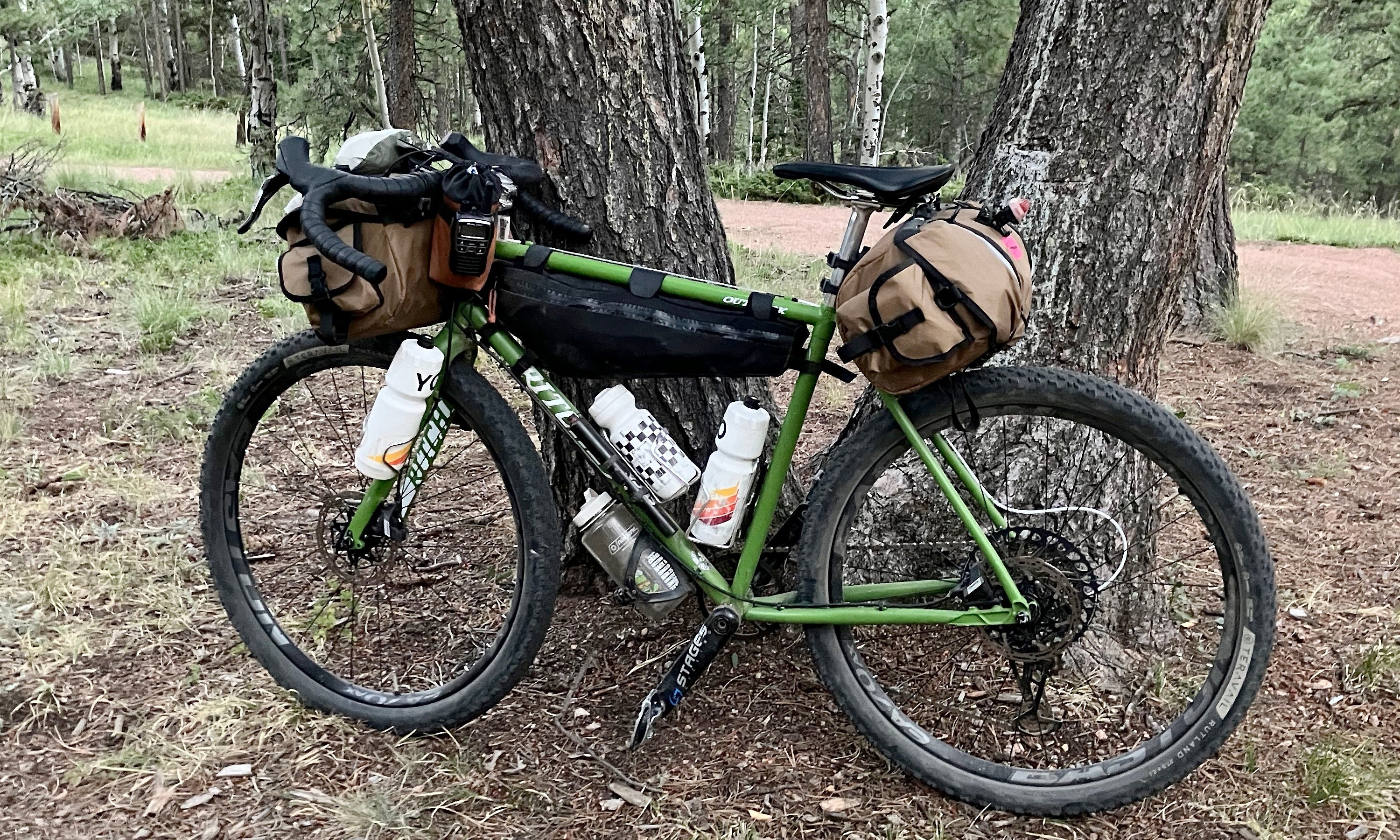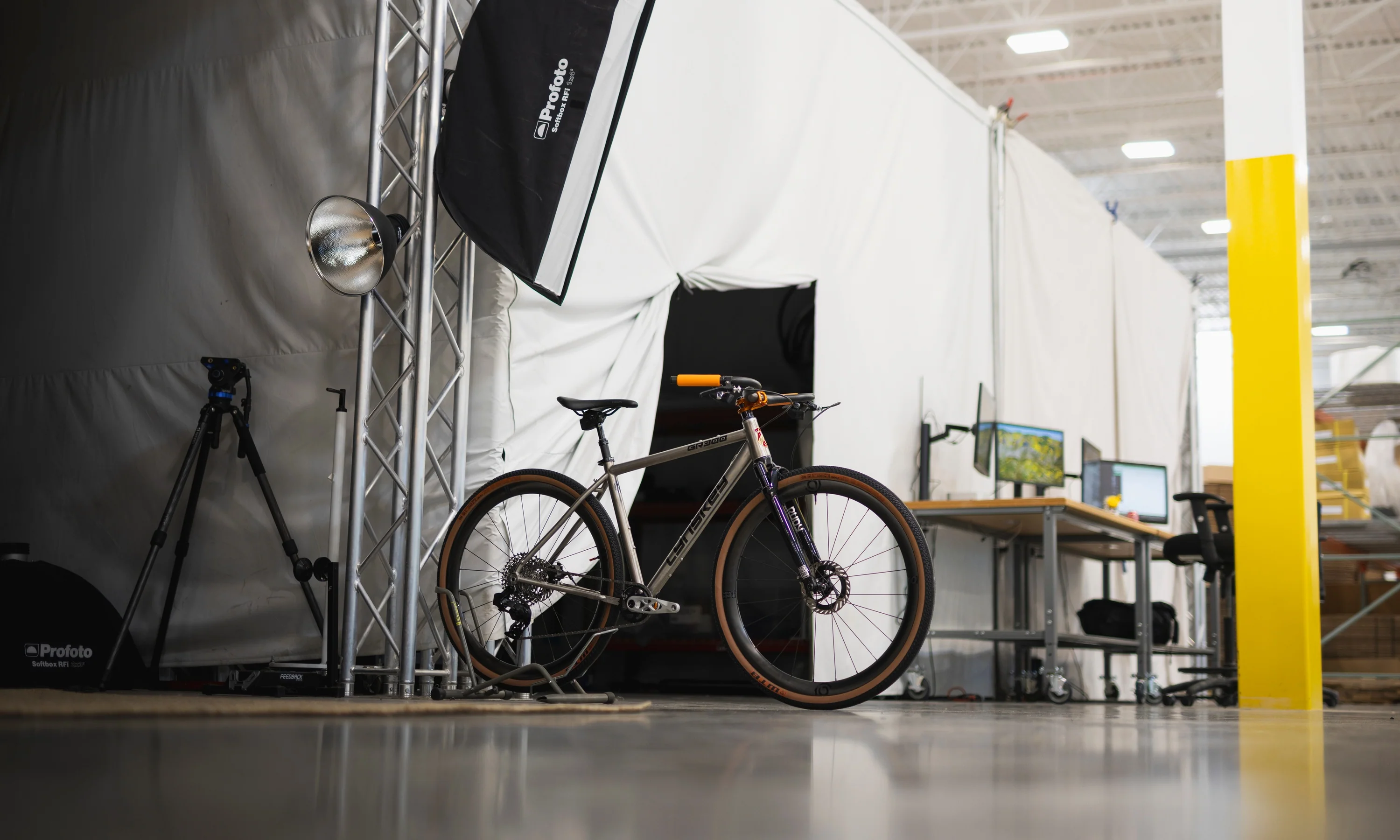When it comes to shredding gravel, there are two bikes that rule the roost: the Specialized Diverge and the Trek Checkpoint. Not only are they both high-tech, highly capable gravel machines, but they are also two of the best-selling bikes in the business.
If you’re interested in a Diverge or Checkpoint, how do you choose between the two? Unfortunately, we can't definitively answer which bike is “better” (sorry). Instead, this comparison aims to explore the history of the two bikes, the technology they use, and the features they offer so you can make the right choice.
Contents
- Diverge vs. Checkpoint: overview
- Future Shock vs. IsoSpeed
- Tire clearance
- Geometry
- Frame weight
- History
- Final thoughts
Diverge vs. Checkpoint: Overview
|
Model |
2022 Specialized Diverge |
2022 Trek Checkpoint |
|
Compliance features |
Future Shock |
IsoSpeed Decoupler |
|
Geometry |
Taller stack, slightly slacker HA |
Longer TT and reach, slightly steeper HA |
|
Tire clearance |
700c x 47mm / 650b x 2.1” |
700c x 45mm / 650b x 2.1” |
|
Carbon frame material |
8r (Base, Sport) / 9r (comp, expert, pro) / 11r (S-Works) |
OCLV 500 (SL) / OCLV 700 (SLR) |
|
Aluminum frame option |
Yes |
Yes |
Future Shock vs. IsoSpeed
 Future Shock is clearly visible beneath the handlebars. The mechanism is hidden by the rubber boot.
Future Shock is clearly visible beneath the handlebars. The mechanism is hidden by the rubber boot.
The Diverge and Checkpoint take two different approaches to improving comfort on gravel roads. Specialized partnered with Formula 1 innovators, McLaren Applied Technologies, to design Future Shock, which uses a spring in the head tube that suspends the rider with 20mm of vertical travel. Specialized chose to use a coil spring system because it can actively absorb the frequencies commonly encountered on road and gravel without adding excessive weight. Springs are also less complex and have less stiction than traditional suspension systems (e.g., an air fork on a mountain bike) and require less force to initiate their travel.
Specialized claims that because Future Shock is positioned under the stem, it doesn’t affect handling or efficiency. The wheelbase doesn’t change through the suspension's travel and there’s no power loss due to a suspension fork compressing. Future shock only suspends the front of the bike. At the rear, the Diverge relies on high-volume tires and seatpost flex for comfort. The top tube slopes down and the seatpost is clamped low to provide ample room for the post to flex when hitting bumps.
 The cover at the seat tube and top tube junction hides the IsoSpeed shaft, bearings, and elastomers that allow the seat tube to flex.
The cover at the seat tube and top tube junction hides the IsoSpeed shaft, bearings, and elastomers that allow the seat tube to flex.
Unlike Future Shock, Trek’s IsoSpeed Decoupler system is a passive system with no moving parts. It provides extra comfort without the weight or complexity of suspension. The top tube is split at the seat tube junction and the seat tube passes through it. The tubes don’t directly touch but are joined by a horizontal shaft and two sealed cartridge bearings. The seat tube can flex fore and aft a few degrees, and between the tubes are two additional elastomer inserts. This helps mute vibrations and bumps that travel through the frame to the saddle but maintains lateral stiffness to keep the bike feeling fast and efficient. The IsoSpeed system used on the high-end SLR model will feel a bit firmer thanks to the added damper.
Both versions of IsoSpeed require little to no maintenance and the bearings and other components are replaceable if needed. The Checkpoint doesn’t use IsoSpeed at the front of the bike because Treks claims high volume gravel tires provide enough compliance, so adding front IsoSpeed is not worth the extra weight or cost.
When it comes to choosing between the two, I suggest riders consider where they value comfort more — in the front or rear. Future Shock is great for riders who experience pain or fatigue in their hands during rough or long rides, while IsoSpeed is similarly good for riders who experience sit bone or lower back pain.
Specialized Diverge vs. Trek Checkpoint: Tire clearance
 Until recently, the Checkpoint had the tire clearance advantage.
Until recently, the Checkpoint had the tire clearance advantage.
|
Model |
Max tire (700c) |
Max tire (650b) |
|
2015 Diverge |
35mm |
N/A |
|
2018 Diverge |
42mm |
47mm |
|
2021 Diverge |
47mm |
2.1” (53mm) |
|
2018 Checkpoint |
45mm |
N/A |
|
2022 Checkpoint |
45mm |
2.1” (53mm) |
Until the release of the 2021 Diverge, the Checkpoint was the clear winner when it came to tire clearance. Now, I would call it a draw. Even though the latest Diverge can clear 47mm tires, tires in the 40-45mm range are the most common. Also, even though it was never officially endorsed by Trek, the 2018-2021 Checkpoint can likely fit 650b wheels and tires with no issues.
Specialized Diverge vs. Trek Checkpoint: Geometry
|
Model |
ETT (56cm) |
Stack |
Reach |
Head angle |
Seat angle |
BB Drop |
Chainstay length |
|
2015 Diverge |
565mm |
589mm |
387mm |
72.5° |
73.25° |
75.5mm |
415mm |
|
2018 Diverge |
561mm |
613mm |
379mm |
72.5° |
73.5° |
85mm |
421mm |
|
2021 Diverge |
573mm |
610mm |
392mm |
71.75° |
73.5° |
80mm |
425mm |
|
2021 Diverge Evo |
600mm (m) |
607mm |
420mm |
70° |
72.5° |
85mm |
432mm |
|
2018 Checkpoint |
566mm |
586mm |
387mm |
72.2° |
73° |
76mm |
425mm |
|
2022 Checkpoint |
584mm |
592mm |
407mm |
72.2° |
72.8° |
76mm |
435mm |
By comparing geometry, it’s clear to see that the latest versions of the Diverge and Checkpoint have moved toward longer reach and chainstays. This has been a common trend for both gravel and mountain bikes because longer bikes are more stable, especially on off-road terrain. Lower bottom brackets and slacker head tube angles also add more stability. One thing to take note of is the stack height. In general, the checkpoint has 10-20mm less stack than a comparable Diverge.
If you lack confidence when going fast or cornering on rough or loose gravel, then longer, lower, and slacker geometry might be better for you. If you prefer more agility or do a lot of road miles, you might prefer shorter, higher, and steeper geometry. Check out our guide to bike geometry to learn more.
Specialized Diverge vs. Trek Checkpoint: Frame weight
|
Model |
Claimed frame weight (56cm) |
|
2018 S-Works Diverge |
880g |
|
2021 Diverge Carbon 9r |
1,095g |
|
2021 Diverge Carbon 8r |
1,195g |
|
2021 S-Works Diverge |
995g |
|
2018 Checkpoint SL |
1,240g |
|
2018 Checkpoint ALR |
1,570g |
|
2022 Checkpoint SL |
1,150g |
|
2022 Checkpoint SLR |
950g |
|
2022 Checkpoint ALR |
1,415g |
The frame weights listed above are for 56cm frames without a fork. I’ve only included weights that have been published online and are easy to find, so you might notice that information is missing for earlier Diverge models because Specialized has not provided it. Also, these are the manufacturer's claimed frame weights, so take them with a grain of salt.
Overall bike weight will mostly come down to the components, but for both the Diverge and the Checkpoint, you can expect carbon models to weigh in between 18-22 pounds, which is very respectable for bikes meant to handle a lot of off-road abuse. Comparing current the top-spec S-Works and SLR models, the Checkpoint just barely wins out. The weights are all close enough though that I don’t consider it a deciding factor.
Diverge vs. Checkpoint: History
If you're curious to learn how these two models have evolved over the years, or want to understand the differences between various generations, read on for a deep dive.
2015-2017 Diverge
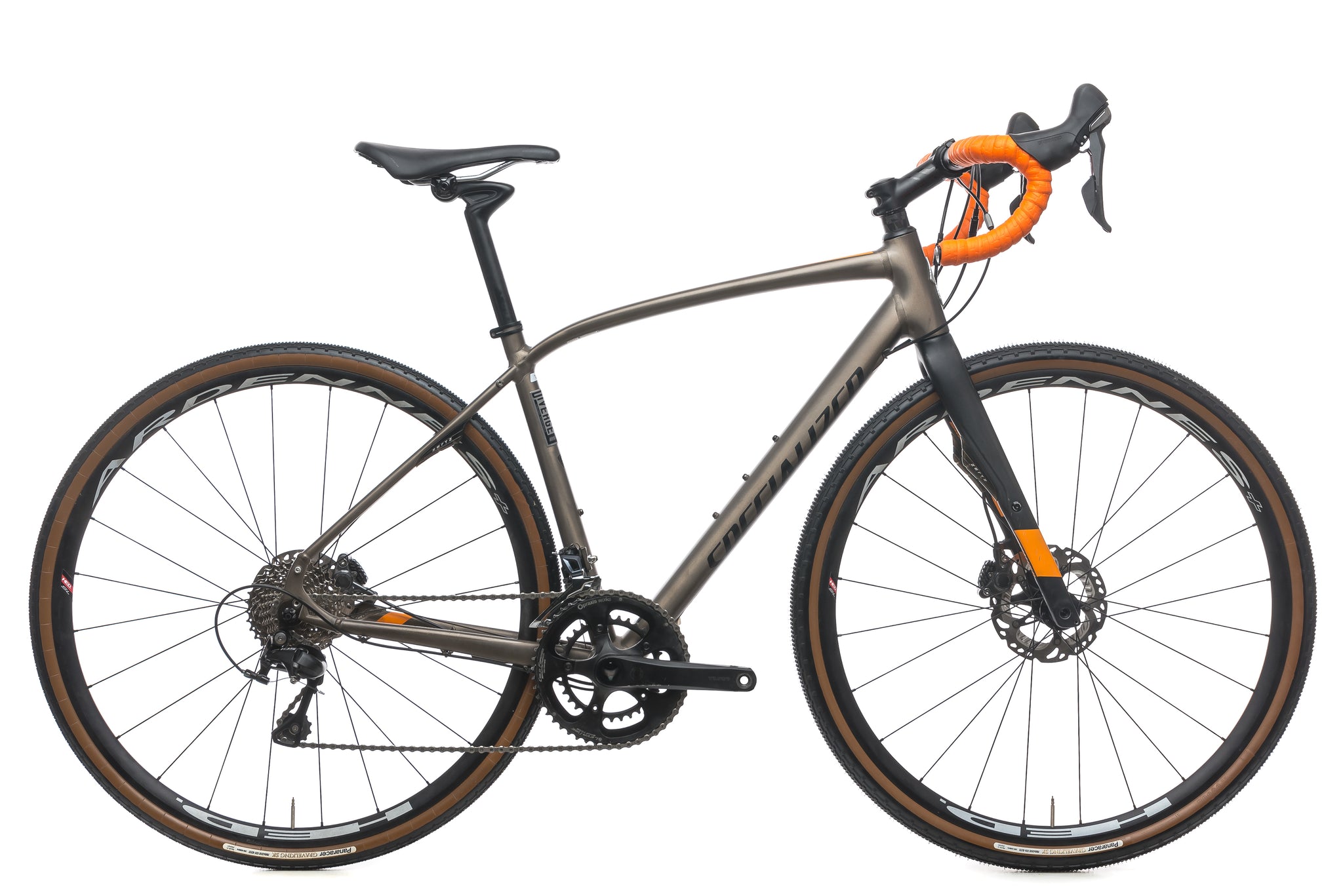 Specialized introduced the first-generation Diverge in 2015 when the gravel scene was relatively new. At the time, it was billed as an “all-road” bike rather than a gravel bike and it came equipped with 32mm tires. Specialized even claimed that the original Diverge was intended for an 80/20 split of road and dirt riding. For riders with greater off-road aspirations, the biggest limiter was tire clearance. The rear end could officially clear a 35mm tire, though some have reported successfully fitting 38mm tires.
Specialized introduced the first-generation Diverge in 2015 when the gravel scene was relatively new. At the time, it was billed as an “all-road” bike rather than a gravel bike and it came equipped with 32mm tires. Specialized even claimed that the original Diverge was intended for an 80/20 split of road and dirt riding. For riders with greater off-road aspirations, the biggest limiter was tire clearance. The rear end could officially clear a 35mm tire, though some have reported successfully fitting 38mm tires.
The Diverge geometry matched the Specialized’s Roubaix endurance road bike, with the one difference being more standover height. The frame came in 10r carbon, SmartWeld E5 aluminum, or basic A1 alloy, and had a large focus placed on compliance. The E5 aluminum frame was as compliant as a carbon Roubaix SL4 frame, with the carbon version being another 6% more compliant. Carbon and E5 frames both used vibration-damping Zertz elastomer inserts in the fork and seat stays, while A1 alloy models use Zertz inserts in the fork with curved seatstays to increase compliance.

Specialized Diverge Carbon Gravel Bike - 2015, 56cm
$4449.99
The bottom bracket used Specialized’s OSBB standard, which is essentially the same as BB30. Notably, the first generation Diverge uses a 15x100mm front axle and Specialized’s proprietary SCS rear axle spacing with a 12x135mm rear axle. This unique axle spacing can limit future wheel upgrade options.
2018-2020 Diverge
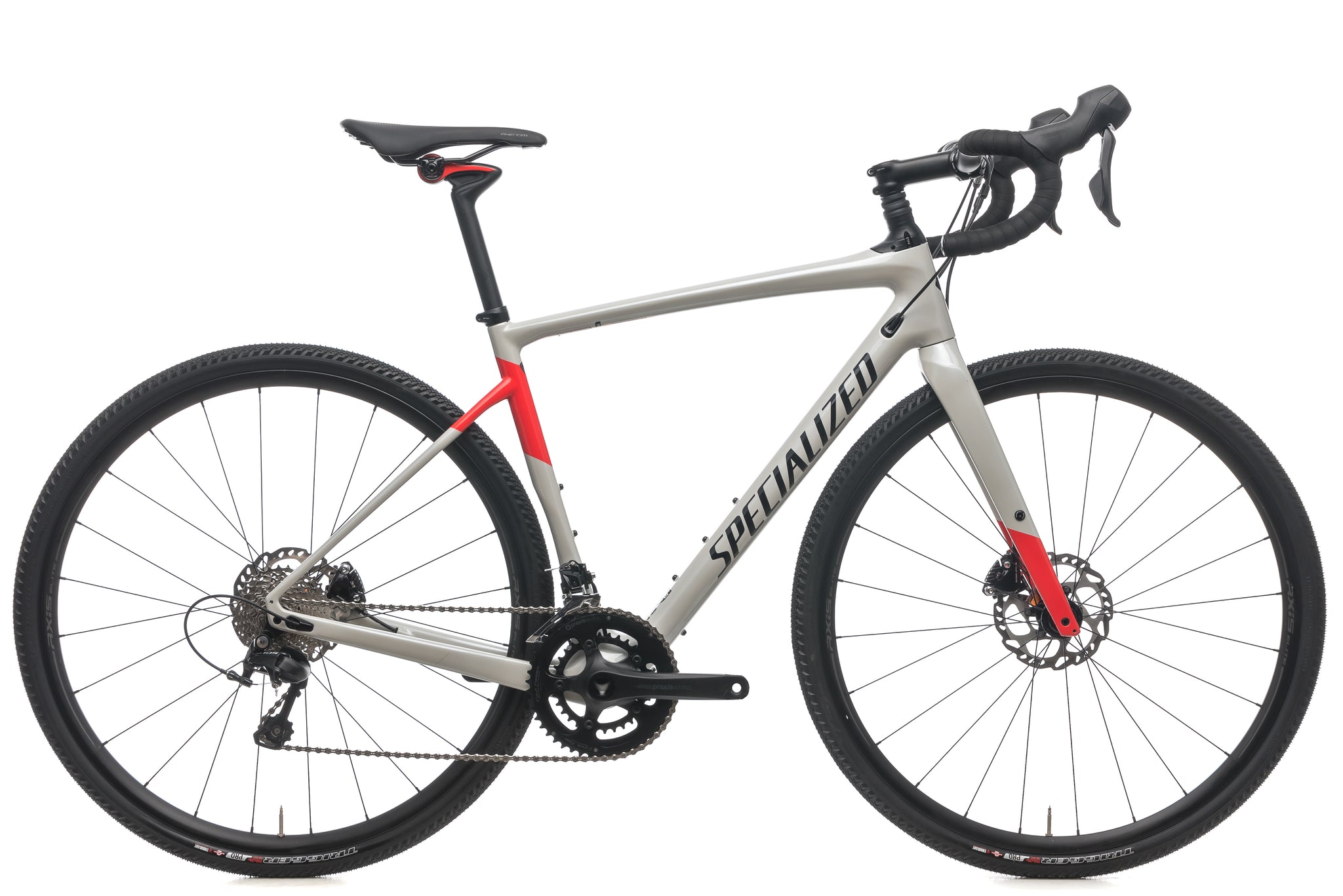 With the second-generation Diverge, Specialized enhanced the frame’s off-road capabilities. The most notable improvements were increased tire clearance, revised geometry, and the addition of Future Shock.
With the second-generation Diverge, Specialized enhanced the frame’s off-road capabilities. The most notable improvements were increased tire clearance, revised geometry, and the addition of Future Shock.
The second-generation Diverge could fit 700c x 42mm or 650b x 47mm tires. The geometry is more stable than its predecessor, with taller stack (mostly due to the addition of Future Shock), lower bottom bracket, longer chain stays, and a slightly slacker head tube.
Then there’s Future Shock, which completely replaced the old Zertz inserts. First introduced on the 2017 Roubaix, Future Shock is a suspension system located under the handlebars that provides 20mm of travel to absorb bumps and increase comfort and control on rough terrain. Springs can be swapped between soft, medium, and hard options to suit different rider weights and preferences.

Specialized S-Works Diverge Gravel Bike - 2019, 58cm
$7349.99
Second-generation Diverge frames came in 9r carbon (which is slightly heavier but also tougher and more compliant than 10r carbon) and E5 aluminum versions. Specialized also added an S-Works model that used high-grade 11r carbon and reduced frame weight to a stunning 880 grams. The axles were updated to standard 12x100mm front and 12x142mm rear thru-axles. The bottom bracket was changed to BB386. Note that the E5 aluminum models are limited to 38mm tires in the rear and the entry-level E5 sport model does not have Future Shock to reduce cost.
2021+ Diverge
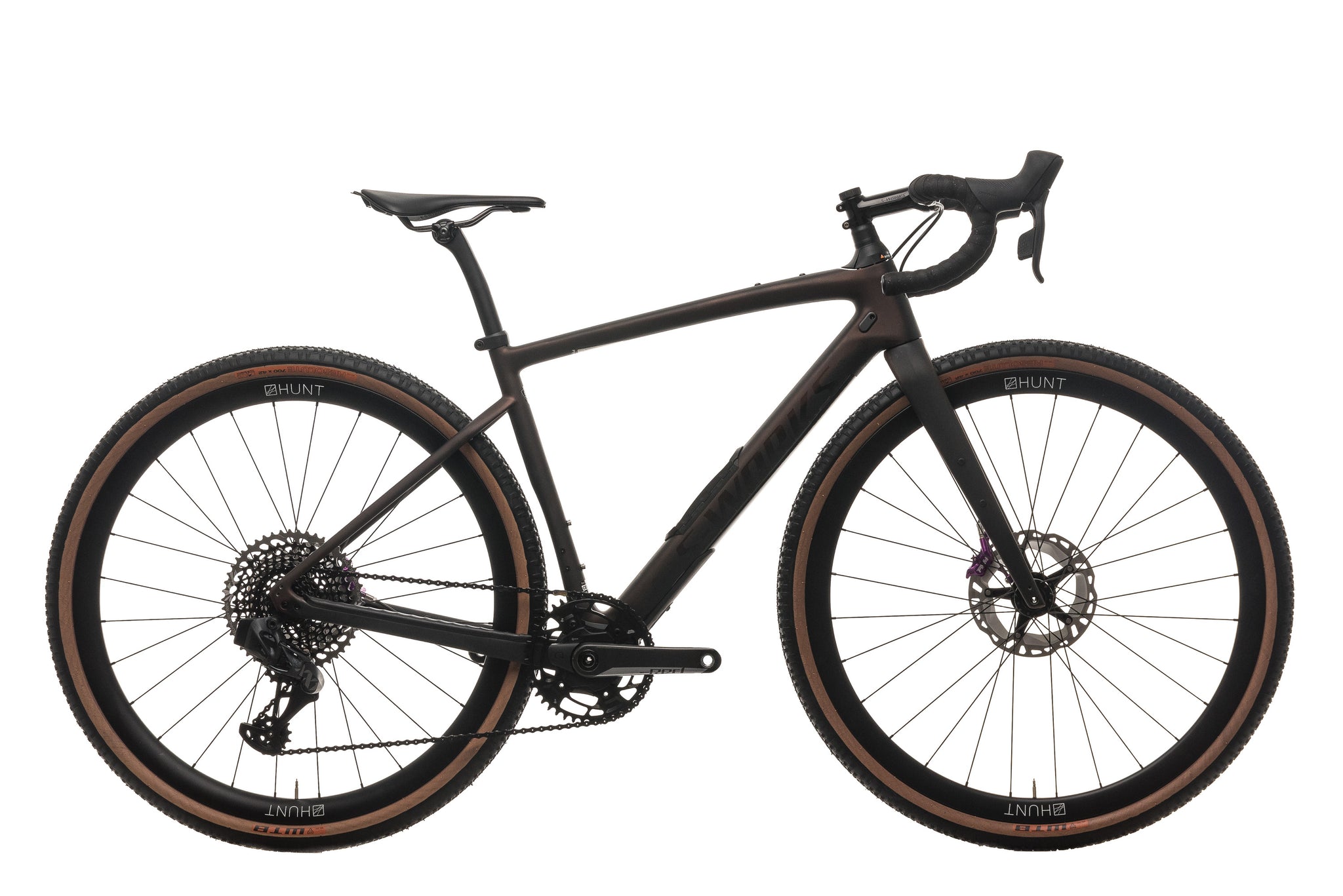 The third-generation Diverge keeps up with current gravel trends with even more tire clearance, slacker geometry, down tube storage, and the new Future Shock 2.0 system.
The third-generation Diverge keeps up with current gravel trends with even more tire clearance, slacker geometry, down tube storage, and the new Future Shock 2.0 system.
Thanks to a narrower chain stay design, tire clearance has grown to allow for massive 700c x 47mm or 650b x 2.1” tires. The head tube has been slacked out by about a degree across all sizes to increase off-road stability. And an internal S.W.A.T. box storage compartment has been added to the down tube on carbon models.
Comp Carbon and above models (which use 9r carbon) get the new Future Shock 2.0 system which adds hydraulic damping to keep it more composed in rough terrain and an adjustment knob that allows riders to toggle between firm and soft settings on the fly. Sport Carbon models (which use lower grade 8r carbon) use Future Shock 1.5, which is similar to the original Future Shock used on the previous generation with no damper and swappable springs.
E5 aluminum models do not have Future Shock, with the exception of the E5 Evo model which uses Future Shock 1.5. The E5 Evo is a unique option that takes inspiration from mountain bikes with flat handlebars, a dropper seatpost, longer reach, and a slacker 70-degree head tube for all sizes. It also only comes in S, M, and L sizes. It’s a fun option for riders who want to explore singletrack trails and gnarlier gravel roads.
Finally, in a move that’s sure to please home mechanics, all carbon and aluminum Diverge models now have traditional BSA threaded bottom brackets.
2018-2021 Checkpoint
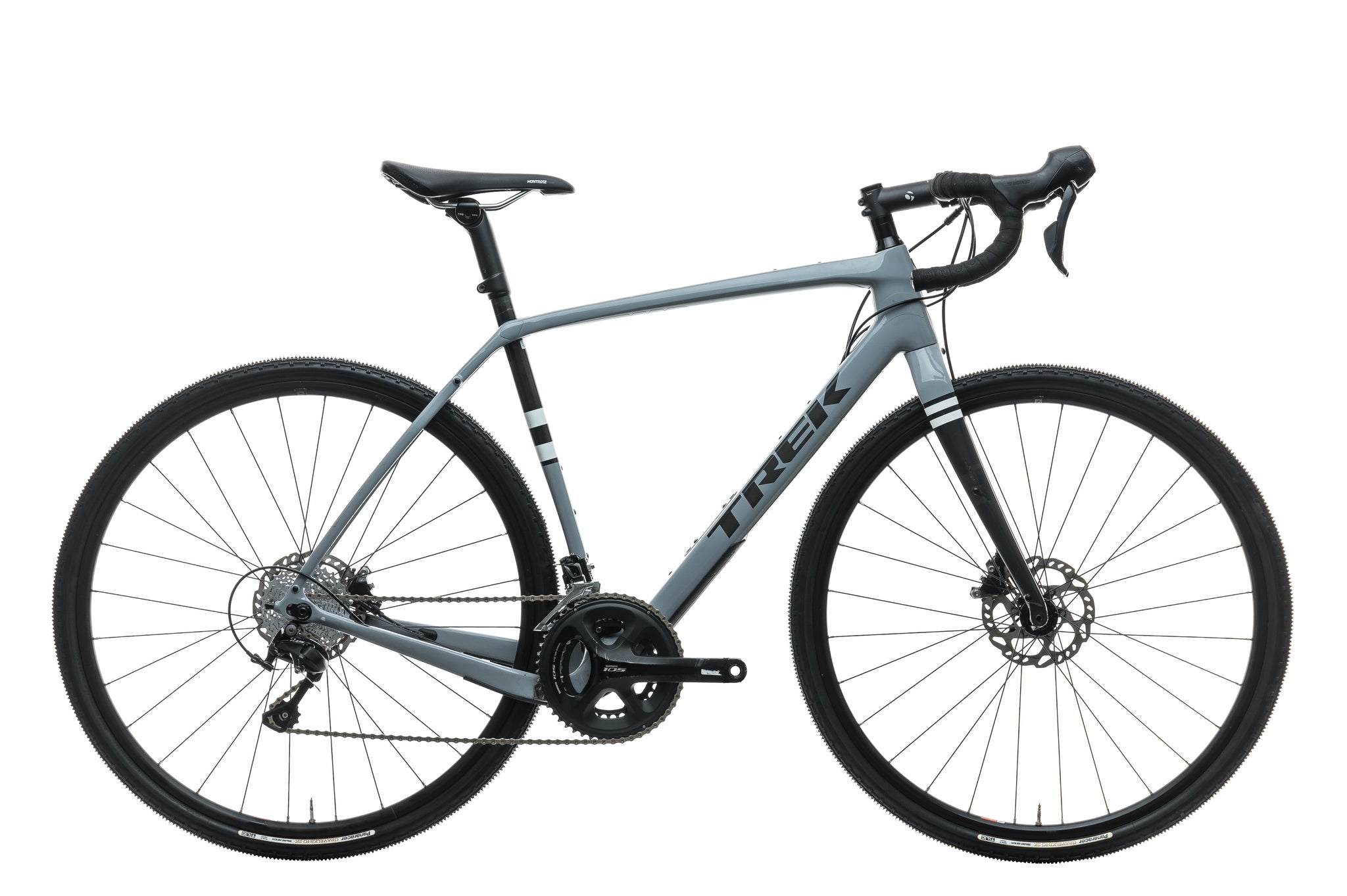 Prior to the Checkpoint, Trek’s only gravel-capable options were cyclocross bikes like the Boone and Crockett, and the experimental Domane Gravel endurance bike. As the industry began settling on the definition of a gravel bike, Trek finally dove in and released its first gravel-specific model: the Checkpoint.
Prior to the Checkpoint, Trek’s only gravel-capable options were cyclocross bikes like the Boone and Crockett, and the experimental Domane Gravel endurance bike. As the industry began settling on the definition of a gravel bike, Trek finally dove in and released its first gravel-specific model: the Checkpoint.
Tire clearance was good from the get-go, with room for wide 700c x 45mm tires. The geometry was carried over from the agile Boone cyclocross bike, with the exception of a lower bottom bracket. Trek claimed this combination of a nimble front end with a lower center of gravity was ideal for riding on fast off-road surfaces. But the Checkpoint also came with Trek’s “Stranglehold” adjustable dropouts. For riders who desired more stability, the rear end could be lengthened up to 15mm to mellow things out. These sliding dropouts also allowed for easy singlespeed setups.
The standout feature though is Trek’s IsoSpeed Decoupler, found on carbon models. IsoSpeed physically decouples the top tube from the seat tube and separates them with elastomers. This allows the seat tube to flex so it can absorb vibrations and bumps, enhancing rider comfort.
The first generation Checkpoint came in either an SL carbon or ALR aluminum frame. The ALR frame does not have the IsoSpeed Decoupler. SL frames used Trek’s OCLV 500 carbon and a BB90 bottom bracket. ALR frames used a standard PF86 bottom bracket.
2022+ Checkpoint
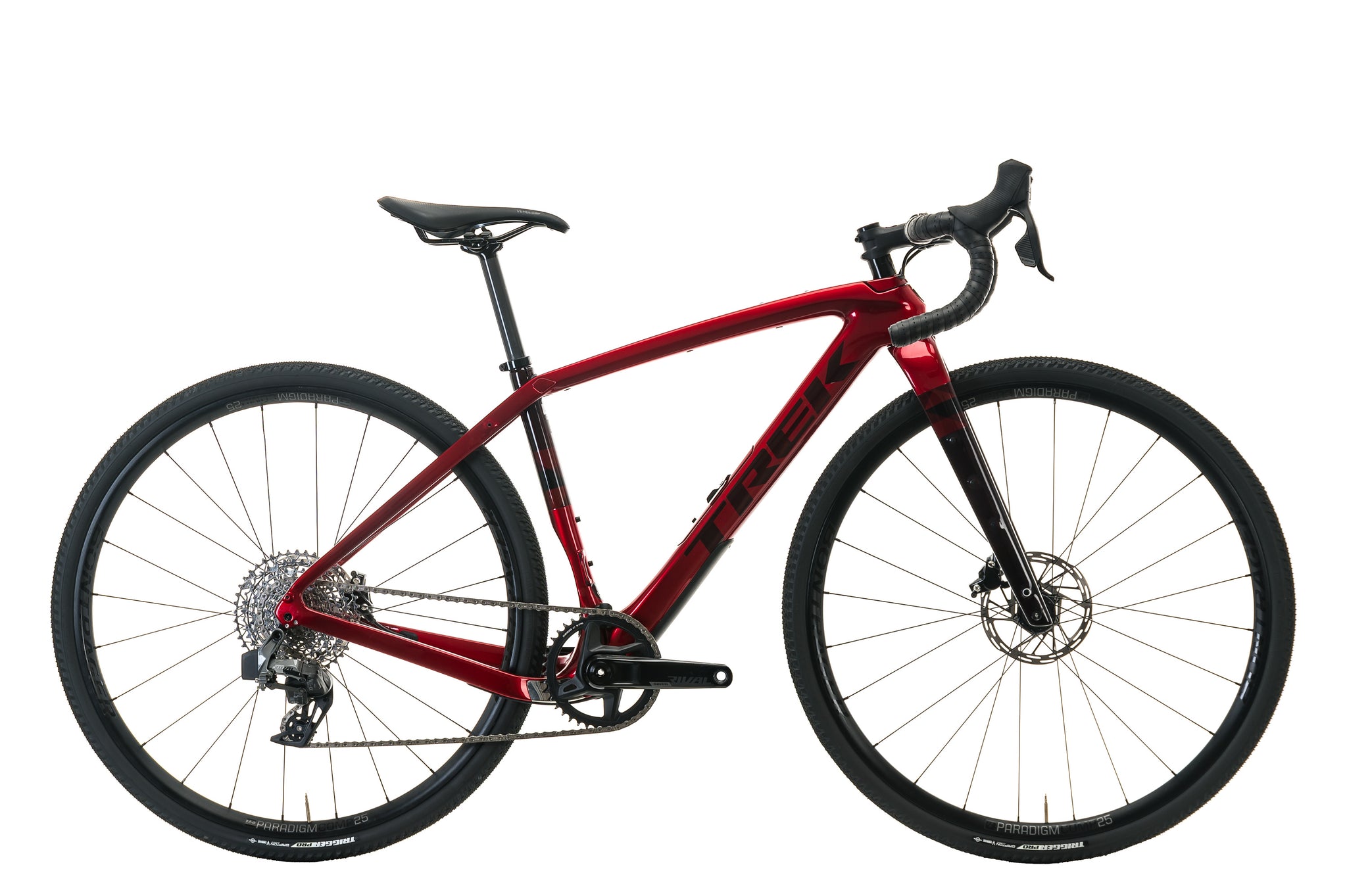 For 2022, the Checkpoint receives a few notable revisions. The biggest change is longer geometry. The reach and front center on the second-generation Checkpoint increased by about 20mm across all sizes. The adjustable Stranglehold rear dropouts are gone and chain stay length increased 10mm. The Checkpoint is now longer, the handling is more stable and forgiving, especially on off-road terrain. Tire clearance has remained the same, but Trek has officially approved the new Checkpoint to also run 650b x 2.1” tires.
For 2022, the Checkpoint receives a few notable revisions. The biggest change is longer geometry. The reach and front center on the second-generation Checkpoint increased by about 20mm across all sizes. The adjustable Stranglehold rear dropouts are gone and chain stay length increased 10mm. The Checkpoint is now longer, the handling is more stable and forgiving, especially on off-road terrain. Tire clearance has remained the same, but Trek has officially approved the new Checkpoint to also run 650b x 2.1” tires.
The Checkpoint has been so popular that Trek decided to add a new SLR carbon model to the line-up, which sits above the SL carbon and ALR aluminum models. The SLR model has a lighter frame built with higher-grade OCLV 700 carbon, and it uses Trek’s latest Top Tube IsoSpeed Decoupler. Top Tube IsoSpeed features an additional elastomer damper in the seat tube to minimize bouncing. It’s also tuned for specific frame sizes, so small frames intended for lighter riders are more compliant than large frames.
SL Carbon checkpoints retain the original IsoSpeed Decoupler design, but they switch from an integrated seat mast to a standard 27.2mm seatpost, which means riders can now run a dropper post if desired. ALR aluminum models still don’t use IsoSpeed but get the same geometry updates as carbon models.
Trek has also added internal down tube storage to the SLR and SL carbon Checkpoint and all Checkpoint models now use threaded T47 bottom brackets.
Specialized Diverge vs. Trek Checkpoint: Final thoughts
If you’ve made it this far, you’ve learned pretty much everything you need to know before purchasing a Specialized Diverge or a Trek Checkpoint. So how do you choose between the two? There are four main factors to consider when comparing them:
- Future Shock vs. IsoSpeed
- Tire Clearance
- Geometry
- Personal taste
The biggest deciding factor is Future Shock vs. IsoSpeed. Every rider’s body is different, and it’s up to you to decide whether you value front-end or rear-end comfort more. For example, I struggle with hand pain on long gravel rides but generally have no issues with my saddle area, so I’d prefer the Diverge. Some riders, however, might not like the active nature of the Future Shock and would prefer the simpler, more passive action of IsoSpeed.
If you intend to run wide 45mm tires, then it will be easier with the Checkpoint. With the Diverge, you’ll be limited to 2022+ models, which may be more expensive and harder to find. Also, if you like having a low handlebar position, it is easier to achieve on the Checkpoint because it has significantly less stack height than the Diverge. Because of the Future Shock, second-and third-generation Diverges have fairly tall front ends. This is great for comfort, but racers often like having lower front ends for better aerodynamics.

Ian Boswell's 2021 Unbound Gravel 200 winning Specialized Diverge. Photo: Wil Matthews.
Finally, both bikes will perform extremely well on gravel and mixed terrain, so it might just make sense to pick the bike you think looks better, or the brand you find yourself more loyal to. If you’re a racing fan, it’s worth noting that the Diverge is the current defending champion of Unbound Gravel 200, the world’s premier gravel race.
Recently, I’ve been digging the look of the new Diverge, so that’s what I’m leaning toward buying. What bike would you choose and why? Let me know in the comments!


